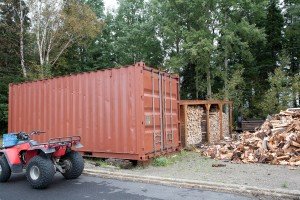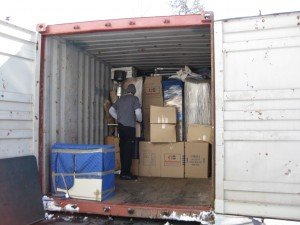Buying a Container: 6 Questions for Smart Container Shopping
You need storage, and you need it now. Perhaps you're out of room for business records, inventory, farm equipment, your stamp collection, or all the bargains you snagged at Costco. The bottom line is, you need space. And if you're thinking a container might do the trick, we like the way you think!
But how do you know for sure if a steel shipping container is the right choice? Here are six questions you need to ask when you're container shopping.
6 Questions to Ask Before Buying a Shipping Container
1) Do I have space for a container?
Standard steel shipping container sizes are 8' wide, 8'6" tall, and either 20' or 40' long. However, the size of the container alone is not the only factor; you need to ensure that you have the space required to get the container trucked in and delivered. This is typically 110-120 feet of straight clearance, including where the container will be placed.
2) What size do I need?
Another question to ask before starting your shipping container purchase is, what size container is best for my needs? The interior of a 20ft shipping container has approximately 150 square feet, whereas a 40ft container has about 300 square feet interior.
For reference, a 20' shipping container can hold the furnishings of a 3-bedroom home. A 40' shipping container can hold about 24 3-foot-wide pallets (or cars and boats). The 40' container is usually a better value for the money. But if you plan on moving the container around regularly, you will want to go with the 20'—it will save you many headaches.
How to Choose the Right Shipping Container






3) Do I need modifications?
Container Modifications
An extra door ("man-door" or roll-up), a window, or extra vents are easy shipping container add-ons. Talking with your shipping container vendor can help you determine what modifications are best suited for your container needs. If you can weld, you can even do many modifications yourself with a modification DIY kit!
Container Security
Containers are constructed from corten steel, which is a weather-resistant material that makes them nearly impenetrable and highly secure. The standard doors on shipping containers are operated by levers, and by attaching a padlock, you can effectively secure the container. If you plan to place your container at a remote cabin or construction site, it may be wise to add a metal lockbox for another layer of protection.
Find the Right Lock for your Shipping Container
Container Appearance and Maintenance
Although corten steel inhibits rust, all steel will rust eventually. If you are buying a used container, it will already show some signs of rust. Fortunately, regular maintenance can help protect your container from weathering and extend its lifespan. Additionally, paint is an inexpensive option that can offer protection and make your container a unique piece of art or advertisement, or it can make your container blend into your site (as much as a massive steel box can!)
Maintenance Checklist for Shipping Containers
4) What container quality do I need?
Asking yourself this question is an important part of buying a shipping container. The type and quality of container you choose will depend on availability, cost and what you will be using your container for.
New or One-Trip Containers
Nearly all shipping containers are manufactured in Asia. From there, they are shipped to the U.S. for sale. These containers are generally gray, tan, or green. New or one-trip containers are rust-free, dent-free, and most will not have shipping-line markings.
Cargo-Worthy Containers
Cargo-worthy containers are used containers that are certified as structurally sound for overseas shipping. These are considered to be the best-quality used containers on the market. Some will have rust, dents, and shipping markings.
Wind and Watertight Containers
This is a small step down from cargo-worthy, but still good, solid containers. Their cargo-worthy status may have expired, or they may have a defect that does not affect storage performance but would not meet the standards for overseas shipping.
As-is Containers
These containers generally will have known problems; it could be a hole in the side, problems with the flooring, or a bad roof. Typically, they are very close in price to a wind and watertight container. However, in most cases, it will cost more to repair than it is worth.
Note: An as-is container is NOT the same as a wind and watertight container sold "as is" with no warranties (vendors cannot warranty a container once it is delivered).
Learn about the Pros and Cons of Buying Used Shipping Containers
5) How do I get a container delivered?
Empty shipping containers are stored at distribution centers across the country. Your vendor will locate an empty container as close to you as possible, and from there, it will be loaded on a truck to be delivered to your destination. Upon delivery, the truck will backup the container right where you want it—all you need is a straight and firm patch of ground (paved, gravel, packed dirt are all fine).
Six Questions for a Smooth Container Delivery
Want to offload the container yourself? That can lower delivery costs—but only if you happen to own a crane, backhoe or forklift.
How about rail delivery? It's not very practical in most cases. Your most cost-effective solution is almost always going to be having your vendor find the closest container to you and put it on a truck. (If you see containers near a rail yard or port, be aware that they are neither empty nor free.)
Planning on shipping overseas? Discuss delivery with your container vendor and shipping line.
5 Tips for Shipping Containers Overseas
6) What should my container cost?
When searching for shipping container vendors, make sure you're comparing apples to apples and watch out for red flags such as too good to be true pricing or poor communication. When considering costs, you'll want to look at the total price including delivery, and make sure quotes are for the same quality of container.
5 Steps to Verify Your Shipping Container Vendor's Legitimacy
Here are three additional tips:
Location matters: Container prices are usually cheaper on the coasts than inland.
Quality matters: A cargo-worthy container costs more than a wind and watertight container. But used 20' and 40' containers should be similar in price.
Delivery details matter: Final costs are determined by how far you are from the closest container and by your specific delivery needs.
Find out more about the Key Factors That Impact the Cost of a Shipping Container
A shipping container is a big purchase, so don’t let the details box you in. Being an informed buyer is important, and asking the right questions while considering factors like type, condition, and delivery can help you make a smart decision. At Super Cubes, we offer expert guidance and a selection of high-quality containers; we'll make sure you find the right fit for your needs. If you need guidance or are looking for a reliable shipping container vendor, reach out to our team today.
This blog was last updated in April 2025.
Super Cubes is a family-owned business located in Minneapolis, MN, that provides containers anywhere in the continental US. We offer personalized service for individuals and businesses, providing high-quality containers at competitive prices. With nationwide facilities, we can modify and deliver containers close to you. Contact our experienced team for your next container project.
Tags:
buy storage container, shipping containers, container modifications, container delivery, container space, container quality, container specs and sizeApril 23, 2025

